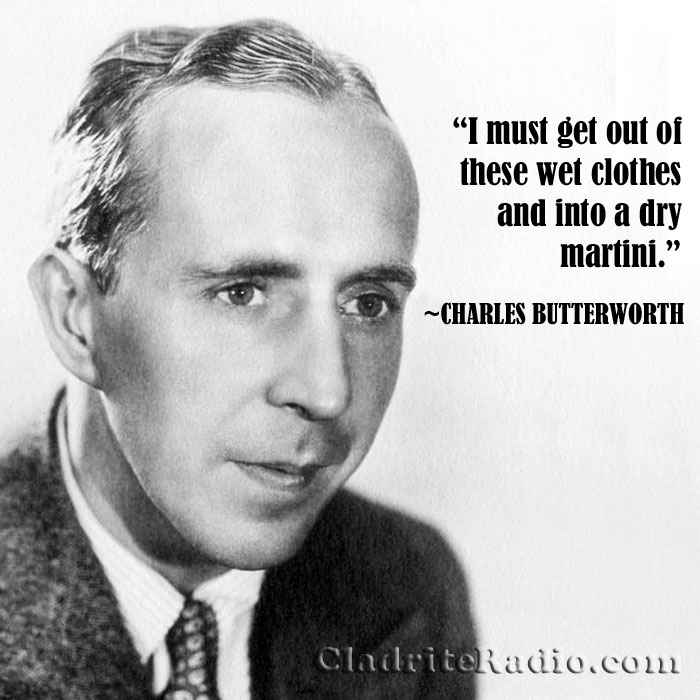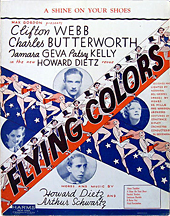Here are 10 things you should know about Buddy Ebsen, born 115 years ago today. In a career that spanned 82 years, he enjoyed success in nightclubs, vaudeville, on Broadway, in pictures, and on television, among other areas of endeavor.
Tag: Flying Colors
Happy 120th Birthday, Charles Butterworth!
Charles Butterworth was born 120 years today in South Bend, Indiana. He’s in the rarefied company of greats like Roland Young, Charles Ruggles and Edward Everett Horton when it comes to making 1930s comedies just that much funnier. Here are ten CB Did-You-Knows:
- Butterworth earned a law degree from the University of Notre Dame, but never practiced, instead entering the journalism field.
- He worked as a journalist for the Chicago American. During those years, he established friendships with Heywood Hale Broun and humorist Frank Sullivan, who was instrumental in Butterworth getting radio work.
- When Butterworth first arrived in New York, he worked for the New York Times as a circulation department canvasser.
- Butterworth also worked as a secretary to author J. P. McEvoy, who was at the time writing the book for a musical called Americana. This gave Butterworth an entrée into the world of theater. He would go on to appear in several Broadway musicals of the 1920s, among them Allez Oop, Good Boy, Sweet Adeline and Flying Colors.
- His first credited film appearance (following a couple of brief, uncredited appearances) was in The Life of the Party (1930).
- Butterworth was known to be adept with humorous ad libs, so much so that some of the screenwriters he worked with in Hollywood came to rely on his ability to fill out an underwritten part with pithy lines of his own making.
- Butterworth was very close friends with fellow humorist Robert Benchley. Benchley is sometimes credited with the line quoted in today’s quote graphic, but he said Butterworth, who spoke the line in Every Day’s a Holiday (1937), but is said to have orginally ad-libbed the quip after falling into a pool at a party.
- Butterworth’s familiar screen character is said to have been the inspiration for cereal mascot Cap’n Crunch.
- He died in 1946 in a single-car automobile accident on Sunset Boulevard. It’s been suggested in some corners that his death was not accidental, that he was despondent over the passing of his pal Benchley some months earlier, but that’s not ever been proven.
- At the time of his death, Butterworth was engaged to actress Natalie Schafer, who would later be cast as Mrs. Thurston Howell III on the television sitcom Gilligan’s Island.
Happy birthday, Charles Butterworth, wherever you may be!

Putting a polish on your day
 Having our shoes shined is one of our favorite simple pleasures, and the reasons are many.
Having our shoes shined is one of our favorite simple pleasures, and the reasons are many.
It’s a rare pleasure, this particular indulgence. We’ve invariably found those who perform the service to be congenial types, and it makes for a pleasant diversion from the day’s duties to take a break, perched on high and glancing at the sports pages, while an amiable gent fusses over one’s shoes (we’ve yet to meet a shoe shine gal, though she can count on our business when we do).
 One definitely get one’s money’s worth with a shoe shine. We’ve rarely paid more than three bucks for this service (though we do fork over more when we step up for a shine at an airport), and the attendants are always conscientious and hard-working.
One definitely get one’s money’s worth with a shoe shine. We’ve rarely paid more than three bucks for this service (though we do fork over more when we step up for a shine at an airport), and the attendants are always conscientious and hard-working.
Compare the humble shoe shine to a professional shave at a barber shop. In NYC, you’ll pay twenty, thirty, even forty bucks for the latter, and while we’ve no doubt it’s a pleasure every bit the equal of the shoe shine, the price renders it an indulgence most of us can’t often allow ourselves.
But three bucks for a full ten minutes of a experienced professional’s services? That’s a bargain that’s hard to beat.
 What’s more, the humble shoe shine presents one the opportunity to be a real sport — you can throw the attendant a five-spot and tell him or her to keep the change. Where else can one improve one’s karma — a 66% tip! — at such a reasonable rate? And even at the airport price of five or six bucks plus tip, a shoe shine is a relative bargain.
What’s more, the humble shoe shine presents one the opportunity to be a real sport — you can throw the attendant a five-spot and tell him or her to keep the change. Where else can one improve one’s karma — a 66% tip! — at such a reasonable rate? And even at the airport price of five or six bucks plus tip, a shoe shine is a relative bargain.
We live in a dressed-down era, of course, with many people wearing sneakers and hiking boots and other casual footwear. While there are still plenty of us who regularly patronize shoe shine stands, for most, it’s something they can only occasionally indulge in.
But we always enjoy the experience, and we highly recommend it to all members of the Cladrite Community.
It’s clear that Arthur Schwartz and Howard Dietz were fellow advocates for the shoe shine experience, given that they wrote a song celebrating the practice of paying for a polish for the 1932 Broadway musical “Flying Colors” (Fred Astaire also performed the song in the 1952 movie musical The Band Wagon):
A Shine On Your Shoes
When you feel as low
as the bottom of a well
and can’t get out of the mood,
do something to perk yourself up
and change your attitude.
Give a tug to your tie,
Put a crease in your pants,
but if you really want to feel fine,
give your shoes a shine.When there’s a shine on your shoes,
there’s a melody in your heart
with a singable happy feeling.
A wonderful way to start
to face the world every day,
with a deedle-dum-dee-dah-dah,
a little melody that is making
the worrying world go by.When you walk down the street
with a happy-go-lucky beat,
you’ll find a lot in what I’m repeating.When there’s a shine on your shoes,
there’s a melody in your heart
What a wonderful way to start the day!
–Dietz & Schwartz
Here’s one of our favorite renditions of the song, recorded by Billy Banks and His Orchestra in 1932.
“When There’s a Shine on Your Shoes” — Billy Banks and His Orchestra
